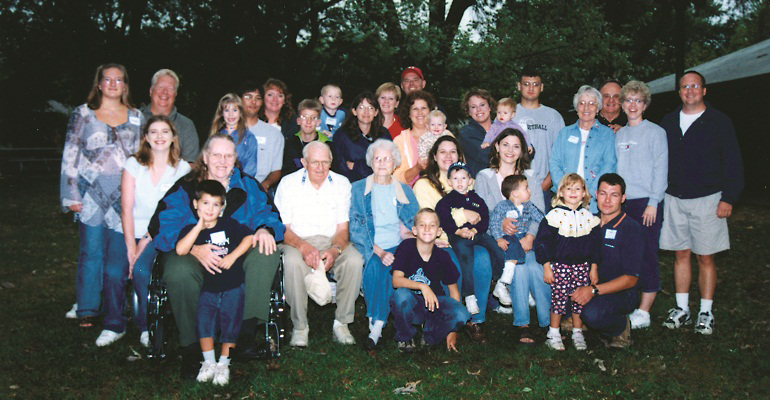During the early years of your open adoption, it may be difficult to imagine yourself and your child’s birth parents growing older and changing. Confidential adoptions froze the images that the adoptive and birth parents had of each other and that the birth parents had of the child.
But open adoption allows you to witness growth and change in each other. These changes will affect how you interact with the birth parents and their extended family. But because your agreement was based on the fact that you were in certain circumstances and the birth parents were in certain circumstances, you may wonder how your agreement will be affected as conditions change.
For example, a birth mother may have selected a particular adoptive couple because she wanted her child to have a stable, two-parent family. Years later, the adoptive parents may be divorced, or experiencing financial or emotional crisis, and the birth mother may be in a stable marriage. You may be different in other ways than you appeared at the time of placement. Adoptive parents who appeared to be infertile may conceive a child later. Birth parents who consoled themselves with the thought that they could have another child when circumstances were better may have difficulty conceiving again or may find that there is never an ideal time to have a child.
It is essential to realize that, although certain circumstances led to the adoption, the adoption plan was not a contract dependent on the preservation of these conditions. The birth parents made a plan based on the information they had available about themselves and about the adoptive parents. They are not expected to be able to predict the future, nor are they responsible for circumstances beyond their control. Similarly, the adoptive parents made a plan based on the information they had available about themselves and about the birth parents.
Of course, it is important for a child to be in an environment free of stress and disruption. But it’s also important for a child to have the stability that comes from having permanent parents. Child- development experts agree that the first three years of a child’s life are extremely important. During this time the child needs to develop trust that his needs will be consistently met by the same people. Children who experience security in early childhood can draw on such resources years later if their family is in crisis. However, children who experience erratic parenting during the first three years of life may have difficulties, such as an inability to identify their own needs or inability to tell right from wrong—even if they later have consistent, loving parents.
When adoptive parents have a change of circumstances that leaves them feeling guilty about having adopted the child, such as a divorce, they may pull away from the birth parents. They may feel that they somehow misled the birth parents, or they may be ashamed of their situation. They need to remember that honesty is the foundation of a relationship, and by not sharing information about their change of circumstances, they may be damaging their relationship with the birth parents.
When adoptive parents share their struggles with birth parents, the birth parents often respond by coming to their assistance. It can help the birth parents to heal and to develop self-respect to be able to help someone else during a time of crisis. Karl and Jody were afraid and ashamed to tell Mio, their child’s birth mother, that they were divorcing. Mio had made an adoption plan because she was in the middle of a divorce herself, and the adoptive parents were worried that she would regret not choosing another couple, or not raising the child herself. When Jody finally informed Mio, her response was kind and supportive: “I really understand how things can change. If you need me, call.”
Why Relationships Change
Sometimes changes in your life and in your family may cause you to renegotiate changes in your level of openness. During the first year after placement, you may have to adjust your expectations of how open your relationship will have to be to meet the realities of your actual needs. Typically, though not always, birth parents find they want more contact and adoptive parents want less. As your relationship develops, you may find yourselves again adjusting the kind of contact you have with each other and the frequency with which you communicate.
Often, the birth parents move on with their lives after the child’s first year or two. If they have completed a significant amount of their grief work, they realize they can’t hang onto the child the way they may have during the first year or so. They resume the roles they had before the birth or take on new ones. This is particularly true for young birth parents who still have much growth and development to accomplish. As they become involved with school, peers, careers, and new relationships, their focus is on themselves and not on the child. This is as it should be. One of the reasons they placed the child for adoption was that they needed to concentrate on themselves before taking on responsibility for another person.
If birth parents pull back from the open adoption relationship to move on with their lives, the adoptive family may still have regular, ongoing contact with other members of the birth family. However, not all birth parents decrease their involvement with the adoptive family. Some move on with their lives but remain committed to the level of involvement they have had with the adoptive family.
When a Birth Parent Marries
Some birth parents are married at the time of the adoption, and some never marry. But it is not unusual for birth parents, especially those who were teenagers or young adults at the time of the birth, to get married a few years later. Occasionally the birth mother and birth father will marry each other after the placement, but usually the birth parents take separate paths.
In some open adoptions, a birth parent’s wedding provides a “coming out” for the child. Although the child’s existence may not have been a secret, the child has probably not been a part of the birth parent’s social life. The birth parent’s wedding may be the first occasion since the child’s birth in which all the people important to the parent are together—immediate family, extended family, distant relatives, close friends, business colleagues, neighbors, and acquaintances. Many open adoptions have a level of closeness that makes it natural for the adoptive family to fit in with this gathering.
Furthermore, the birth parent’s wedding symbolizes her movement to a new level of personal growth. Including the child placed for adoption in the marriage celebration can say, “This is a person important to me.” But it can also say much more. It may be the birth parent’s way of saying that the child is a part of her past life, and will remain an important part of her future life.
Some birth parents want the child to be part of the wedding party, usually as ring bearer or flower girl. Think carefully about the significance of attending a birth parent’s wedding or having the child participate as part of the wedding party. In one situation, the adoptive parents agreed to attend the wedding but declined to allow the child to be the ring bearer. They felt his presence on the altar would draw attention away from the wedding, placing an emphasis on the birth mother’s past rather than her future. Some adoptive parents have expressed concern that, even as part of the congregation, their child would be the focus of too much attention. However, others welcome the opportunity to wish the birth parent well and have their child meet more people in the birth parent’s familial and social circle.
Adoptive parents often welcome the involvement of the birth parent’s spouse in the open adoption, especially when the partner appears to have had a stabilizing effect on a previously disorganized birth parent. Sometimes, however, a birth parent’s new spouse or partner can cause the adoptive parents to reevaluate the open adoption arrangement. Fred and Nita genuinely cared for their child’s birth mother, Cassie, and trusted her to take the child on short trips to the park or the movies. But when Cassie became involved with a new boyfriend, Fred and Nita were concerned. They suspected him of drug use and felt he could be violent, and they did not want him around their child. They explained to Cassie that they were concerned not only for their child but for her, who they feared was also vulnerable in the new relationship. They explained that they in no way wanted to restrict her access to the child, but that, as long as they were concerned about this boyfriend, Cassie could see the child only under their supervision. Cassie was angry and hurt. She accused them of going back on their open adoption agreement. The incident has severely damaged their relationship, but because Cassie wants to continue to see the child, they still communicate.
Birth parents may want less contact with the adoptive family after they have other children, both because they have less time for other relationships and because it can be hard to see all the children together and wonder what it would have been like to raise them together. After the birth mother grieves for this loss—one that she couldn’t have grieved for at the time of the placement—she may be able to resume visits.
Other Reasons for Change
One of the more difficult changes that families may encounter is a birth parent who regrets her decision. When Lucille learned from the birth mother that she felt coerced by her parents into making an adoption plan, and that she had regretted the decision ever since, all the fears Lucille had about open adoption resurfaced. She was afraid the birth mother would attempt to kidnap the child or challenge her role as a parent. Lucille insisted that the birth mother receive counseling and offered to pay for it. While the birth mother continued to believe she should have raised the child herself, she was eventually able to accept the fact that she could not change her decision.
Sometimes the birth- or adoptive parents move, causing them to change the frequency or type of contact they have with each other. Sometimes personal crises, such as illness in the family, leave people without any energy to maintain relationships.
If changes in circumstances cause you or your child’s birth parents to want or need to change the level of openness you once had, renegotiate that change. Don’t passively allow yourselves to slip out of each other’s lives. Someone needs to verbalize what is happening: “It seems like we’re not hearing from you as much. Is there something going on?” The other person can then explain her circumstances. Also, make a commitment to staying in touch at some minimal level. More change is likely, and the time may come when you want to resume your previous level of openness.
From the book THE OPEN ADOPTION EXPERIENCE: Complete Guide for Adoptive and Birth Families, by Lois R. Melina and Sharon K. Roszia. Copyright © 2003 by the authors. Published by arrangement with HarperCollins Publishers.


